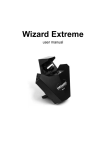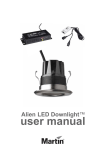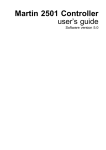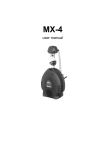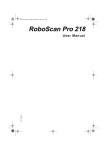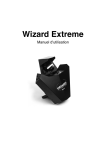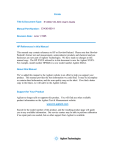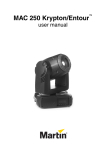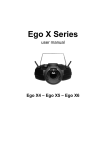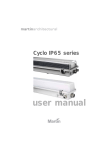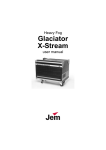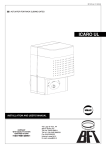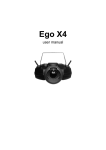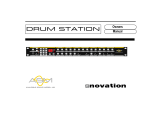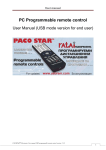Download "user manual"
Transcript
Wizard Extreme user manual 1. Data sockets 2. Power and Data LEDs 6 7 3. Power input, main fuse, power on/off switch 4. DIP switch 5. Safety cable eye 6. Mounting bracket 7. Lamp housing 8. Swivel locks 9. Focus rod (see illustration below right) 1 2 3 4 5 8 Cover access screws 516 208 9 552 110 Measurements are in millimeters © 2004-2007 Martin Professional A/S, Denmark. All rights reserved. No part of this manual may be reproduced, in any form or by any means, without permission in writing from Martin Professional A/S, Denmark. Information subject to change without notice. Martin Professional A/S and all affiliated companies disclaim liability for any injury, damage, direct or indirect loss, consequential or economic loss or any other loss occasioned by the use of, inability to use or reliance on the information contained in this manual. P/N 35000155, Rev. F Introduction . . . . . . . . . . . . . . . . . . . . . . . . . . . . . . . . . . . . . . . . . . . 5 Safety information . . . . . . . . . . . . . . . . . . . . . . . . . . . . . . . . . . . . . 5 Unpacking . . . . . . . . . . . . . . . . . . . . . . . . . . . . . . . . . . . . . . . . . . . 7 AC power . . . . . . . . . . . . . . . . . . . . . . . . . . . . . . . . . . . . . . . . . . . . . 8 Installing a plug on the mains lead . . . . . . . . . . . . . . . . . . . . . . . . 8 Adjusting voltage settings . . . . . . . . . . . . . . . . . . . . . . . . . . . . . . . 8 Installation . . . . . . . . . . . . . . . . . . . . . . . . . . . . . . . . . . . . . . . . . . . 11 Wall mounting . . . . . . . . . . . . . . . . . . . . . . . . . . . . . . . . . . . . . . . 11 Overhead mounting . . . . . . . . . . . . . . . . . . . . . . . . . . . . . . . . . . . 12 Operation from the floor . . . . . . . . . . . . . . . . . . . . . . . . . . . . . . . 12 Multi-coupler bracket . . . . . . . . . . . . . . . . . . . . . . . . . . . . . . . . . . 14 Data connection . . . . . . . . . . . . . . . . . . . . . . . . . . . . . . . . . . . . . . 15 Recommended cable . . . . . . . . . . . . . . . . . . . . . . . . . . . . . . . . . 15 Connections . . . . . . . . . . . . . . . . . . . . . . . . . . . . . . . . . . . . . . . . 15 Stand-alone operation . . . . . . . . . . . . . . . . . . . . . . . . . . . . . . . . 17 Single-unit operation . . . . . . . . . . . . . . . . . . . . . . . . . . . . . . . . . . 17 Master / slave operation . . . . . . . . . . . . . . . . . . . . . . . . . . . . . . . 17 Stand-alone settings . . . . . . . . . . . . . . . . . . . . . . . . . . . . . . . . . . 19 MC-1 operation . . . . . . . . . . . . . . . . . . . . . . . . . . . . . . . . . . . . . . . 20 MC-1 settings . . . . . . . . . . . . . . . . . . . . . . . . . . . . . . . . . . . . . . . 20 DMX operation . . . . . . . . . . . . . . . . . . . . . . . . . . . . . . . . . . . . . . . 21 DMX modes . . . . . . . . . . . . . . . . . . . . . . . . . . . . . . . . . . . . . . . . 21 Setting the DMX mode . . . . . . . . . . . . . . . . . . . . . . . . . . . . . . . . 24 DMX control address . . . . . . . . . . . . . . . . . . . . . . . . . . . . . . . . . . 24 Basic service . . . . . . . . . . . . . . . . . . . . . . . . . . . . . . . . . . . . . . . . . 26 Cleaning . . . . . . . . . . . . . . . . . . . . . . . . . . . . . . . . . . . . . . . . . . . 26 Lamp maintenance . . . . . . . . . . . . . . . . . . . . . . . . . . . . . . . . . . . 29 Fuses . . . . . . . . . . . . . . . . . . . . . . . . . . . . . . . . . . . . . . . . . . . . . 31 Setting Wizard emulation and 1-channel modes . . . . . . . . . . . . . 32 Updating firmware . . . . . . . . . . . . . . . . . . . . . . . . . . . . . . . . . . . . 32 Troubleshooting . . . . . . . . . . . . . . . . . . . . . . . . . . . . . . . . . . . . . . 34 DMX protocol: 11-channel mode . . . . . . . . . . . . . . . . . . . . . . . 35 DMX protocol: Wizard emulation 8-channel mode . . . . . . . 38 DMX protocol: 1-channel mode . . . . . . . . . . . . . . . . . . . . . . . . 40 Wizard Extreme specifications . . . . . . . . . . . . . . . . . . . . . . . . 41 Disposing of this product Martin® products are supplied in compliance with Directive 2002/96/EC of the European Parliament and of the Council of the European Union on WEEE (Waste Electrical and Electronic Equipment), as amended by Directive 2003/108/EC, where applicable. Help preserve the environment! Ensure that this product is recycled at the end of its life. Your supplier can give details of local arrangements for the disposal of Martin® products. I NTRODUCTION Thank you for selecting the Martin Wizard Extreme. The Wizard Extreme is an automated lighting fixture that features: • 12 factory-designed macros that allow light shows to be created quickly with minimal programming • Strobe effects • Two independent color/gobo wheels • Seven solid colors, eight-split colors, and two white positions • 13 gobos plus open position • A rotating mirror dish • A rotating mirror drum with variable swivel angle • Adjustable focus with rapid adjustment mechanism • Mechanical shutter • Multiple control options that enable a broad range of effects The combination of mirror dish and mirror drum delivers over 80 individual light beams. A new glass reflector design offers enhanced light output. SAFETY INFORMATION Warning! This product is not for household use. It presents risks of lethal or severe injury due to fire and heat, electric shock, and falls. Read this manual before powering or installing the fixture, follow the safety precautions listed below and observe all warnings in this manual and printed on the fixture. If you have questions about how to operate the fixture safely, please contact a Martin distributor for assistance. Refer any service operation not described in this manual to a qualified technician. Do not modify the fixture or install other than genuine Martin accessories and upgrade kits. Avoi di ng electric shocks • Disconnect the fixture from AC power before removing or installing the lamp, fuses, or any part, and when not in use. • Always ground (earth) the fixture electrically. Introduction 5 • Use only a source of AC power that complies with local building and electrical codes and has both overload and ground-fault protection. • Do not expose the fixture to rain or moisture. • Refer all service to a qualified technician. • Never operate the fixture with missing or damaged lenses and/or covers. Prot ecting yourself and others from burns and fire • Never attempt to bypass the thermostatic switch or fuses. Always replace defective fuses with ones of the specified type and rating. • Ensure that the air flow through fans and vents is free and unobstructed. • Keep all combustible materials (for example fabric, wood, paper) at least 0.3 meters (12 inches) away from the fixture. Keep flammable materials well away from the fixture. • Do not illuminate surfaces within 0.1 meters (4 inches) of the fixture. • Provide a minimum clearance of 0.1 meters (4 inches) around fans and air vents. • Replace the lamp if it becomes defective or worn out, or before usage exceeds the maximum service life. When replacing the lamp, allow the fixture to cool for at least 5 minutes before opening the fixture or removing the lamp. Protect your hands and eyes with gloves and safety glasses. It can take up to 15 minutes for the fixture to cool completely. • Never place filters or other materials over the lens or mirror drum. • The exterior of the fixture can reach temperatures up to 60° C (140° F) and the screws on the lamp plate can reach up to 90° C (194° F). Allow the fixture to cool for at least 5 minutes before handling. • Do not operate the fixture if the ambient temperature (Ta) exceeds 40° C (104° F). • Do not stare directly into the light. • Never operate the fixture without all lenses and covers installed: an unshielded lamp can explode without warning and emits dangerous UV radiation that can cause burns and eye damage. • Covers, shields, lenses or ultraviolet screens must be changed if they have become visibly damaged. • The lamp must be changed if it has become damaged or thermally deformed. Preventing injuri es due to fall s • When suspending the fixture above ground level, verify that the structure can hold at least 10 times the weight of all installed devices. 6 Wizard Extreme user manual • Verify that all external covers and rigging hardware are securely fastened and use an approved means of secondary attachment such as a safety cable. • Block access below the work area whenever installing or removing the fixture. UNPACKING The packing material is carefully designed to protect the fixture during shipment – always use it to transport the fixture. The Wizard Extreme is supplied with the following: • 3-wire power cable. • This user manual. The latest version of this manual is also available in the support area of the Martin website at http://www.martin.com Introduction 7 AC POWER The Wizard Extreme’s operating voltage is printed on the serial number label that can be found on the back of the Wizard Extreme. Verify that the operating voltage closely matches the AC supply voltage before applying power. Contact your Martin dealer if the operating voltage differs from your supply voltage by more than five percent. INSTALLING A PLUG ON THE MAINS LEAD The fixture’s mains lead may require a grounding-type cord cap that fits your power distribution cable or outlet. Consult a qualified electrician if you have any doubts about proper installation. Warning! For protection from dangerous electric shock, the fixture must be grounded (earthed). The AC mains supply shall have overload and ground-fault protection. Important! Verify that the feed cables are undamaged and rated for the current requirements of all connected devices before use. Following the cord cap manufacturer’s instructions, connect the yellow and green wire to ground (earth), the brown wire to live, and the blue wire to neutral. The table below shows some pin identification schemes. Wire Pin Marking Screw color brown live “L” yellow or brass blue neutral “N” silver yellow/green ground ADJUSTING VOLTAGE SETTINGS EU Model 1. Disconnect the fixture from AC power. 8 Wizard Extreme user manual green 230 V 240 V 250 V Ballast Transformer 240 V 225 V 0V Local AC Supply Transformer Ballast Freq. Voltage Setting Terminal Setting / Terminal 50 Hz 220 - 235 V 225 V 3 230 V 50 Hz 235 - 245 V 240 V 4 240 V 50 Hz 245 - 260 V 240 V 4 250 V 2. If the lamp is hot, allow it to cool for 5 minutes and wear safety goggles to protect your eyes. 3. Remove the six cover-access screws (see diagram inside the cover of this manual) and lift of the fixture cover. 4. On the transformer, move the BROWN wire to the transformer terminal shown in the table above for the local AC supply voltage. The terminals are indicated on a label on the top of the transformer. 5. On the ballast, move the BROWN wire to the terminal listed for the voltage. The terminals are indicated on the top of the ballast. 6. Replace the cover. AC power 9 US model Local AC Voltage Transformer taps 95 - 110 V Blue wire: 20V Brown wire: 120 V 110 - 130 V Blue wire: 0 V Brown wire: 120 V 200 - 220 V Blue wire: 20 V Brown wire: 230 V 220 - 240 V Blue wire: 0 V Brown wire: 230 V 240 - 260 V Blue wire: 0 V Brown wire: 250 V 225 V / 60 Hz 225 V / 50 Hz Transformer Ballast 250 V 230 V 120 V 20 V 0V 1. Disconnect the fixture from AC power. 2. If the lamp is hot, allow it to cool for 5 minutes and wear safety goggles to protect your eyes. 3. Remove the six cover-access screws (see diagram inside the cover of this manual) and lift off the fixture cover. 4. On the ballast, move the BLACK wire to the 225 V / 50 Hz terminal if you have 50 Hz local AC power, or to the 225 V / 60 Hz terminal if you have 60 Hz local AC power. 5. On the transformer, move the BLUE and BROWN wires to the taps listed in the table above for your local AC voltage. Taps are identified by a label on the top of the transformer. 6. Replace the cover. 10 Wizard Extreme user manual I NSTALLATION The Wizard Extreme can be hung overhead with a clamp (not included), mounted vertically on a wall, or placed on the floor (using the optional floor stand). Warning! Block access below the work area before proceeding. Always use a secure means of secondary attachment. WALL MOUNTING To mount the Wizard Extreme on a wall, or other vertical surface: 1. Verify that the surface is capable of bearing the weight of the fixture. 2. Set two 8mm-diameter hex bolts or screws, 155 mm (6.1 in.) apart (center to center), in the mounting surface. 3. Set an eyebolt in the mounting surface for the safety cable. 4. Fold the mounting bracket so that it lies flat against the back of the fixture and tighten the swivel locks. We recommend that you remove the swivel locks and replace them with M8 hexagonal lock nuts (these can be supplied by your Martin dealer: 2 x P/N 08132701); alternatively set the swivel locks so that they lie flat against the fixture. Ø8mm max 13 mm / ½" 5. Hang the fixture on the wall over the two screw/bolt heads using the two slotted holes in the mounting bracket. 6. Install a safety cable that can hold at least 10 times the weight of the fixture through the safety cable eye on the fixture and attach this to the eyebolt. 7. Verify that the fixture is at least 0.1 meters (4 in.) from the surface to be illuminated and at least 0.3 meters (12 in.) from any combustible materials. Verify that the clearance around the air vents is at least 0.1 meters (4 in.). Installation 11 OVERHEAD MOUNTING To hang the Wizard Extreme on an overhead support: 1. Verify that the structure can support at least 10 times the weight of all installed fixtures, clamps, cables, auxiliary equipment, and other items. 2. If hanging the fixture with a rigging clamp, verify that the clamp is undamaged and is designed for the fixture’s weight. Bolt the clamp securely to the bracket with a grade 8.8 (minimum) M12 bolt and lock nut, or as recommended by the clamp manufacturer, through the clamp hole in the mounting bracket. 3. If permanently installing the fixture, verify that the hardware (not included) and mounting surface can bear at least 10 times the fixture’s weight. Any of the six 13mm (½ in.) holes in the mounting bracket may be used for attachment, but ensure that the load is distributed evenly. 4. Working from a stable platform, clamp or fasten the fixture to the structure. 5. Install a safety cable that can hold at least 10 times the weight of the fixture through the safety cable eye on the fixture (see illustration on right). 6. Loosen the swivel locks, tilt t he fi xtu r e to th e de sired angle, and retighten. 7. Verify that the fixture is at least 0.1 meters (4 in.) from the surface to be illuminated and at least 0.3 meters (12 in.) from any combustible materials. Verify that the clearance around the air vents is at least 0.1 meters (4 in.). OPERATION FROM THE FLOOR To operate the Wizard Extreme from the floor, you need the optional floor stand (P/N: 91606008). The stand is designed for use on a flat surface. It is not intended to be used in any other way. 1. Attach the floor stand to the mounting bracket. The floor stand is longer at one end. Install the stand so that the long end is positioned 12 Wizard Extreme user manual where the load is greatest. This will depend on the angle that the Wizard Extreme is set at. 2. Place the fixture on the floor. Adjust the mounting bracket and tighten both swivel locks. 3. Verify that the fixture is stable, that it is at least 0.1 meters (4 in.) from the surface to be illuminated and at least 0.3 meters (12 in.) from any combustible materials. Verify that the clearance around the air vents is at least 0.1 meters (4 in.). Installation 13 MULTI-COUPLER BRACKET Installing multiple Wizard and/or Wizard Extremes can be made easier by using the Wizard multi-coupler bracket that is available as an accessory (P/N: 91606008). Example multi-coupler bracket installations Instructions for installing Wizard Extreme fixtures on the multi-coupler bracket are supplied with the bracket. They are also available in the Wizard section of the Support area on the Martin website at http://www.martin.com 14 Wizard Extreme user manual D ATA CONNECTION This section describes how to connect fixtures to each other, or to a controller. RECOMMENDED CABLE A reliable data connection requires suitable cable. Standard microphone cable cannot transmit DMX data reliably over long runs. For best results, use cable specifically designed for RS-485 applications. Your Martin dealer can supply suitable high-quality cable in various lengths. CONNECTIONS The Wizard Extreme’s XLR data sockets are wired with pin 1 to ground, pin 2 to signal - (cold), and pin 3 to signal + (hot). This is compatible with the standard for DMX devices. One or more adaptor cables may be required to connect the Wizard Extreme to the controller and/or other lights because many devices have 5-pin connectors and others may have reversed signal polarity, that is, pin 2 hot and pin 3 cold. 5-pin to 3-pin Adaptor 3-pin to 5-pin Adaptor Male Female Male Female Male Female 1 2 3 4 5 1 2 3 1 2 3 1 2 3 4 5 1 2 3 1 2 3 P/N 11820005 P/N 11820004 Data connection 3-pin to 3-pin Phase-Reversing Adaptor P/N 11820006 15 Connecting the data link 1. Connect a data cable to the controller’s output. If controller has a 5-pin output, use a 5-pin male to 3-pin female adaptor cable (P/N 11820005). 2. Lead the data cable from the controller to the first fixture. Plug the cable into the fixture’s data input. 3. Connect the output of the fixture closest to the controller to the input of the next fixture. If connecting two fixtures with opposing polarity on pins 2 and 3, insert a phase-reversing cable between the two fixtures. 4. Continue connecting fixtures output to input. Up to 32 devices may be connected on a serial link. 5. Terminate the link by inserting a male termination plug (P/N 91613017) into the data output of the last fixture. A termination plug is simply an XLR connector with a 120 ohm, 0.25 W resistor soldered across pins 2 and 3. Male Termination Plug Female Termination Plug Male XLR Female XLR 1 2 3 120 Ohm P/N 91613017 16 1 2 3 120 Ohm P/N 91613018 Wizard Extreme user manual STAND-ALONE OPERATION The Wizard Extreme can be operated without a DMX controller in standalone mode. A Wizard Extreme in stand-alone mode can be operated as a single unit or together with other Wizard Extremes in a “master/slave” configuration. Several options are available in stand-alone operation. This chapter describes these options and explains how to select them using the DIPswitch. Important! The Wizard Extreme transmits a control signal when it is set as master (i.e. DIP-switch pins 2 and 10 are set to ON). To avoid damage to the electronics, do not connect more than 1 master to the data link. • If you have Wizard Extremes set to single-unit operation and you want to connect them to a data link, set them as slaves before connecting them to the link. • If you have a Wizard Extreme set as master and you want to use a different fixture on the data link as master, set the existing master to slave before you set the new master. SINGLE-UNIT OPERATION The Wizard Extreme can be set to operate independently of other fixtures in either music trigger or auto trigger mode. No data link is needed for this mode of operation. Single-unit operation, with options for trigger type and effect movement speed, can be selected as described under “Stand-alone settings” on page 19. MASTER / SLAVE OPERATION Multiple Wizard Extremes can be connected together on a data link without a controller for synchronized “master/slave” operation in which slave fixtures can be set to behave identically with, or respond to, the behavior of the master. Stand-alone operation 17 Fixtures must be connected in a ‘daisy chain’, i.e. the link must not be split into separate branches. It is possible to set any fixture as master, but it is most convenient to set the first fixture on the link. Important! Set only 1 fixture as master (DIP-switch pins 2 and 10 ON) or you may cause damage to your fixtures. Connecting units for master / slave operation 1. Connect the output of one Wizard Extreme to the input of the next. 2. Connect additional Wizard Extremes output to input. Up to 32 may be connected. 3. Terminate the link on both ends by inserting a female termination plug into the data input of the first fixture and a male termination plug into the data output of the last fixture. The female terminator may not be required if you set the first fixture on the link as master. A termination plug is simply an XLR connector with a 120 ohm, 0.25 W resistor soldered across pins 2 and 3. Setting the mast er (auto trig) 2. Set DIP-switch pins 3, 5, 6, 7, 8, 9, and 11 to OFF. ON 1. Set DIP-switch pins 2 and 10 to ON. 1 2 3 4 5 6 7 8 9 10 11 12 3. Set DIP-switch pin 4 to ON for slow effects action or OFF for fast action (see “Stand-alone settings” on page 19). Setting the mast er (musi c tri g) 2. Set DIP-switch pins 3, 5, 6, 7, 8, 9, and 11 to OFF. ON 1. Set DIP-switch pins 1, 2 and 10 to ON. 1 2 3 4 5 6 7 8 9 10 11 12 3. Set DIP-switch pin 4 to ON for slow effects action or OFF for fast action (see “Stand-alone settings” on page 19). Setting a slave Set DIP-switch pin10 to ON. 2. Set pins 1, 2, 3, 4, 5 and 11 to OFF. ON 1 1 2 3 4 5 6 7 8 9 10 11 12 3. Select options with DIP-switch pins 6, 7, 8, and 9 (see “Stand-alone settings” on page 19). If none of these options are set, the slave fixture will copy the master exactly. If one or more of these options is set, the slave fixture will be synchronized with the master but show different effects. 18 Wizard Extreme user manual STAND-ALONE SETTINGS DIP-switch pins 1-9 enable stand-alone options only when pin 10 is ON. When pin 10 is off, the DIP-switch selects a DMX address. Pin 11 must be OFF for stand-alone operation. After setting DIP-switch 10, the Wizard Extreme must be powered off and then on again to activate or deactivate stand-alone operation. Fixture Single or master Slave Option Setting (0 = OFF, 1 = ON) 1 2 3 4 5 6 7 8 9 10 11 Auto trigger, fast movement 0 1 0 0 0 0 0 0 0 1 0 Auto trigger, slow movement 0 1 0 1 0 0 0 0 0 1 0 Music trigger, fast movement 1 1 0 0 0 0 0 0 0 1 0 Music trigger, slow movement 1 1 0 1 0 0 0 0 0 1 0 Identical to master 0 0 0 0 0 0 0 0 0 1 0 Use a different color in relation to the master 0 0 0 0 0 1 1 0 Use a different gobo in relation to the master 0 0 0 0 0 1 0 Rotate the mirror drum in the opposite direction to the master 0 0 0 0 0 1 0 Swivel the mirror drum in the opposite direction to the master 0 0 0 0 0 1 0 Mirror drum rotation Stand-alone operation 1 1 1 Mirror drum swivel 19 MC-1 OPERATION The Wizard Extreme is fully compatible with the Martin MC-1 controller. This chapter explains how to configure the Wizard Extreme for operation with an MC-1. For further information, refer to the MC-1 user manual. MC-1 SETTINGS To control a Wizard Extreme using a Martin MC-1 controller, DIP-switch pin 10 must be set to OFF. The Wizard Extreme must also be set to Wizard emulation 8-channel mode by moving a jumper on the circuit board. This procedure is described in “Setting Wizard emulation and 1channel modes” on page 32. Changes to these settings do not take effect until the fixture has been powered off and on. DIP-switch pins 6, 7, 8, and 9 provide special options that are most useful when operating multiple Wizard Extremes from a single MC-1. Fixtures with these options selected will respond to the same commands but react differently than Wizard Extremes with standard settings. This allows you to make a light show more diverse but retain synchronized control of your fixtures. Option Setting (0 = OFF, 1 = ON) 1 2 3 4 Use a different color Use a different gobo Rotate the mirror drum in the opposite direction Swivel the mirror drum in the opposite direction 20 Wizard Extreme user manual 5 6 7 8 9 1 1 1 1 10 11 0 1 0 1 0 1 0 1 DMX OPERATION The Wizard Extreme can be connected to and operated from a DMX controller. To do this you need to: 1. Choose and set one of the three DMX modes. These three modes are described in the following sections, “DMX modes” and “Setting the DMX mode” 2. Set a DMX control address. This is described in “DMX control address” on page 24. DMX MODES The Wizard Extreme can be operated in three DMX modes: • 11-channel mode provides position control of all effects, plus twelve factory-set macros, plus control of mirror drum swivel rate, plus control of color and gobo wheel change speed. • Wizard emulation 8-channel mode emulates the original bestselling Wizard fixture, providing position control of all effects, control of the mirror drum swivel rate, and color and gobo wheel change speed. • 1-channel mode allows control of the built-in stand-alone features during music trig operation Full details of the 11-channel, Wizard emulation and 1-channel mode functions are listed in the DMX protocol sections on pages 35 - 40. 1 1 - c h an n el D M X o p er at i o n Channel 1 controls lamp on, lamp off, the dimmer and the strobe rate. It also allows you to execute a random “stand-alone” program using automatic or music trigger, and to reset all effects to their home positions. Channel 2 controls the rotation of the mirror dish. This channel has no effect if the stand-alone program is selected on channel 1. Channel 3 controls the color wheel and is used to select colors, split colors, the twinkle effect and color rotation. When the stand-alone program is running, this channel still has active control of the color wheel unless the DMX value is set to greater than 250 (>98%). DMX operation 21 Channel 4 controls the color wheel shake function. Color wheel shake can be set to narrow or wide, and shake speed adjusted. Channel 5 controls the gobo wheel. This channel functions even if the stand-alone program is selected. When the stand-alone program is running this channel still has active control of the gobo wheel, unless the DMX value is set to greater than 250 (>98%). Channel 6 controls the gobo wheel shake function. Gobo wheel shake can be set to narrow or wide, and shake speed adjusted. Channel 7 controls mirror drum swivel (pan) position and shake. This channel has no effect if the stand-alone program is running. Channel 8 controls mirror drum rotation (tilt) direction, speed and shake. This channel has no effect if the stand-alone program is running. Channel 9 allows one of 12 factory-set macros to be selected. The macros are mini-programs that use all the fixture’s effects. Select a macro if you want fast access to impressive light effects with minimal programming. Channel 10 controls the mirror drum swivel (pan) speed. Adjusting this allows you to program fades on controllers without faders. If fade times can be programmed on your controller and you use this function, turn the speed function off and set mirror drum swivel to tracking by setting channel 10 to zero. This channel has no effect if the stand-alone program is running. Channel 11 provides speed control of the color and gobo wheels, allowing you to program slow or fast transitions from one effect position to another. This channel has no effect if the stand-alone program is running. Wizard emulation 8-channel DMX operation In Wizard emulation 8-channel mode, the Wizard Extreme emulates the original Wizard fixture, using the original Wizard’s 8-channel extended DMX mode. If Wizard emulation mode is set, the Wizard Extreme can be added to an existing installation of Wizards and will behave exactly as if it was a Wizard in 8-channel mode. Channel 1 controls lamp on, lamp off, the dimmer and the strobe rate. It also allows you to execute a random “stand-alone” program using automatic or music trigger, and to reset all effects to their home positions. Channel 2 controls the rotation of the mirror dish. This channel has no effect if the stand-alone program is selected on channel 1. 22 Wizard Extreme user manual Channel 3 controls the color wheel and is used to select colors, split colors, the twinkle effect and color rotation. When the stand-alone program is running, this channel still has active control of the color wheel unless the DMX value is set to greater than 250 (>98%). Channel 4 controls the gobo wheel. This channel functions even if the stand-alone program is selected. When the stand-alone program is running, this channel still has active control of the gobo wheel unless the DMX value is set to greater than 250 (>98%). Channel 5 controls the mirror drum’s swivel (pan) position. This channel has no effect if the stand-alone program is running. Channel 6 controls mirror drum rotation (tilt), direction and speed. This channel has no effect if the stand-alone program is running. Channel 7 controls the mirror drum swivel (pan) speed. Adjusting this allows you to program fades on controllers without faders. If fade times can be programmed on your controller and you use this function, turn the speed function off and set mirror drum swivel to tracking by setting channel 7 to zero. This channel has no effect if the stand-alone program is running. Channel 8 provides speed control of the color and gobo wheels, allowing you to program slow or fast transitions from one effect position to another. This channel has no effect if the stand-alone program is running. 1-channel DMX/music trig operation Setting the Wizard Extreme to 1-channel operation can be useful if the number of channels available on your DMX controller is limited, but you still want some level of control over your fixtures. If you set the Wizard Extreme to 1-channel DMX mode and select a stand-alone function, the fixture operates in music trig mode, but you can control of the following functions on the DMX channel. Note that multiple fixtures cannot be synchronized in this mode. DMX value Percent Function 0-10 11-20 21-80 81-115 116-140 141-175 176-210 211-255 0-3 4-7 8-31 32-44 45-54 55-68 69-82 83-100 Light off Light on Strobe Slow music trig (every 2 seconds) Medium music trig (every second) Fast music trig (every 0.2 seconds) Random music trig (between 0.2-2.0 seconds) Trigger whenever DMX value 240 is crossed DMX operation 23 SETTING THE DMX MODE 1. Disconnect the fixture from power. 2. To set the Wizard Extreme to: • 11-channel DMX mode set DIP-switch pins 10 and 11 to OFF. • Wizard emulation 8 channel DMX mode reset jumper PL118 on the circuit board (see “Setting Wizard emulation and 1-channel modes” on page 32) and set DIP-switch pins 10 and 11 to OFF. • 1-channel DMX mode reset jumper PL118 on the circuit board (see “Setting Wizard emulation and 1-channel modes” on page 32) and set DIP-switch pin 10 to OFF and pin 11 to ON. DMX CONTROL ADDRESS The control address, also known as the start channel, is the first channel used to receive instructions from the controller. Each fixture needs its own control address set, and uses this address and subsequent control channels to receive instructions from a controller. When the Wizard Extreme is in 11-channel mode, it reads the DMX data on the start channel and the next ten channels. If the DMX control address is set to 100, the fixture uses channels 100 - 110. Channel 111 is available for use as the control address for the next fixture. If the Wizard Extreme is set to Wizard emulation 8-channel mode, it reads the DMX data on the start channel and the next seven channels. If the Wizard Extreme is set to 1-channel mode, it reads the DMX data on the start channel only. For independent control, a fixture must not use any DMX channel used by another fixture. If two or more fixtures are set up with the same address, they will receive the same instructions and should behave identically. Setting up identical fixtures with the same address is a good tool for troubleshooting unexpected behavior and an easy way to achieve synchronized action. Specifying a DMX address DIP-switch pins 1-9 are used to set the control address: 1. Select an address for the fixture on your controller. If you are calculating the DMX addresses for multiple fixtures, save time by using the Martin Address Calculator at http://www.martin.dk/service/utilities/AddrCalc/index.asp 24 Wizard Extreme user manual 2. Look up the DIP-switch setting using the Martin DIP Switch Calculator at http://www.martin.dk/service/dipswitchpopup.htm or look for the address in the DIP-switch settings table below. 3. Disconnect the fixture from power. 4. Set pins 1 through 9 to the ON (1) or OFF (0) position as listed in the table. Find the address in the following table. Read the settings for pins 1 - 5 to the left and read the settings for pins 6 - 9 above the address. “0” means OFF and “1” means ON. Pin 10 is always OFF for DMX operation. DIP-Switch Setting #1 0 1 0 1 0 1 0 1 0 1 0 1 0 1 0 1 0 1 0 1 0 1 0 1 0 1 0 1 0 1 0 1 0 = OFF 1 = ON #2 #3 #4 0 0 0 0 0 0 1 0 0 1 0 0 0 1 0 0 1 0 1 1 0 1 1 0 0 0 1 0 0 1 1 0 1 1 0 1 0 1 1 0 1 1 1 1 1 1 1 1 0 0 0 0 0 0 1 0 0 1 0 0 0 1 0 0 1 0 1 1 0 1 1 0 0 0 1 0 0 1 1 0 1 1 0 1 0 1 1 0 1 1 1 1 1 1 1 1 #5 0 0 0 0 0 0 0 0 0 0 0 0 0 0 0 0 1 1 1 1 1 1 1 1 1 1 1 1 1 1 1 1 #9 #8 #7 #6 0 0 0 0 0 0 0 1 0 0 1 0 0 0 1 1 0 1 0 0 0 1 0 1 0 1 1 0 0 1 1 1 1 0 0 0 1 0 0 1 1 0 1 0 1 0 1 1 1 1 0 0 1 1 0 1 1 1 1 0 1 1 1 1 1 2 3 4 5 6 7 8 9 10 11 12 13 14 15 16 17 18 19 20 21 22 23 24 25 26 27 28 29 30 31 32 33 34 35 36 37 38 39 40 41 42 43 44 45 46 47 48 49 50 51 52 53 54 55 56 57 58 59 60 61 62 63 64 65 66 67 68 69 70 71 72 73 74 75 76 77 78 79 80 81 82 83 84 85 86 87 88 89 90 91 92 93 94 95 96 97 98 99 100 101 102 103 104 105 106 107 108 109 110 111 112 113 114 115 116 117 118 119 120 121 122 123 124 125 126 127 128 129 130 131 132 133 134 135 136 137 138 139 140 141 142 143 144 145 146 147 148 149 150 151 152 153 154 155 156 157 158 159 160 161 162 163 164 165 166 167 168 169 170 171 172 173 174 175 176 177 178 179 180 181 182 183 184 185 186 187 188 189 190 191 192 193 194 195 196 197 198 199 200 201 202 203 204 205 206 207 208 209 210 211 212 213 214 215 216 217 218 219 220 221 222 223 224 225 226 227 228 229 230 231 232 233 234 235 236 237 238 239 240 241 242 243 244 245 246 247 248 249 250 251 252 253 254 255 256 257 258 259 260 261 262 263 264 265 266 267 268 269 270 271 272 273 274 275 276 277 278 279 280 281 282 283 284 285 286 287 288 289 290 291 292 293 294 295 296 297 298 299 300 301 302 303 304 305 306 307 308 309 310 311 312 313 314 315 316 317 318 319 320 321 322 323 324 325 326 327 328 329 330 331 332 333 334 335 336 337 338 339 340 341 342 343 344 345 346 347 348 349 350 351 352 353 354 355 356 357 358 359 360 361 362 363 364 365 366 367 368 369 370 371 372 373 374 375 376 377 378 379 380 381 382 383 384 385 386 387 388 389 390 391 392 393 394 395 396 397 398 399 400 401 402 403 404 405 406 407 408 409 410 411 412 413 414 415 416 417 418 419 420 421 422 423 424 425 426 427 428 429 430 431 432 433 434 435 436 437 438 439 440 441 442 443 444 445 446 447 448 449 450 451 452 453 454 455 456 457 458 459 460 461 462 463 464 465 466 467 468 469 470 471 472 473 474 475 476 477 478 479 480 481 482 483 484 485 486 487 488 489 490 491 492 493 494 495 496 497 498 499 500 501 502 503 504 505 506 507 508 509 510 511 DMX operation 25 B ASIC SERVICE This chapter describes the maintenance procedures that you can perform yourself: 1 “Cleaning” 2. “Lamp maintenance” 3. “Fuses” 4. “Setting Wizard emulation and 1-channel modes” 5. “Updating firmware” CLEANING Regular cleaning of the elements in the optical path, as well as the fans and air vents, is vital to maintaining the operational quality of the Wizard Extreme. Cleaning intervals depend on the operating environment. Check fixtures regularly and clean if necessary. Important! Excessive dust, smoke fluid, and particulate buildup degrades performance and causes overheating and damage to the fixture that is not covered by the warranty. Cleaning the fan and air vents To maintain adequate cooling, dust must be cleaned from the fan and air vents. The Wizard Extreme fan can be removed from the fixture to give access for cleaning. To clean the fan: 1. Disconnect the fixture from power and allow it to cool completely. 26 Wizard Extreme user manual 2. Pull the two locking pins on the fan up to release it, and lift up the outer edge of the fan (illustration A). A 3. Slide the fan out of the fixture housing (illustration B). B 4. When the fan is clear of the housing, lift it up for access to the fan blades. 5. Remove dust from the fan and grille with a soft brush, cotton swab, vacuum, or compressed air. 6. Replace the fan in the housing and push down on the two locking pins to secure it. Basic service 27 Cleaning optical components Clean the optical components regularly. The presence of smudges or dust on optical surfaces can reduce the strength of the light output and the quality of the effects. The following illustration shows the elements that need to be kept clean: Lamp reflector Lamp Mirror drum Heat filter Lens Shutter Gobo wheel Mirror dish Color wheel Use care when cleaning optical components and work in a clean, well lit area. The coated surfaces are fragile and easily scratched. Do not use solvents that can damage plastic or painted surfaces. 1. Disconnect the fixture from power and allow the components to cool completely. 2. Remove the fixture cover. You may want to remove the lamp for cleaning (see the related steps in “Installing a lamp in the Wizard Extreme” on page 29). 3. Vacuum or gently blow away dust and loose particles with compressed air. 4. Remove stuck particles with an unscented tissue or cotton swab moistened with glass cleaner or distilled water. Do not rub the surface: lift the particles off with a soft repeated press. 5. Remove smoke and other residues with cotton swabs or unscented tissues moistened with isopropyl alcohol. A commercial glass cleaner may be used, but residues must be removed with distilled water. Clean 28 Wizard Extreme user manual with a slow circular motion from center to edge. Dry with a clean, soft and lint-free cloth or compressed air. 6. Replace the fixture cover (and lamp-access cover) before applying power. LAMP MAINTENANCE The Wizard Extreme is supplied with an Osram HSD 250W/80 long-life discharge lamp installed. This lamp has an average life of 3000 hours, a color temperature of 8000 K and a color rendering index greater than 85. Lamp envelopes weaken with age, so to reduce the risk of lamp explosion replace the lamp when it reaches the limit of its service life as specified by the manufacturer. The following lamp types are supported: • • • • • Osram HSD 250/80 Osram HSD 250/78 Osram HSD 250/60 Philips MSD 250/2 Philips MSD 200 Important! Installing any other lamp may damage the fixture. Allow the lamp to cool for at least 5 minutes before packing and moving the fixture. To avoid possible damage, remove the lamp when shipping the fixture. Warning! Always disconnect the fixture from AC power and allow it to cool for at least 5 minutes before installing the lamp. The screws on the lamp plate can reach 90° C (194° F) during operation. Installing a lamp in the Wi zard Extreme 1. Disconnect the fixture from AC power. If replacing a lamp, allow it to cool for at least 5 minutes before removing the lamp-access cover. The lamp cools faster with the cover in place. It can take up to 15 minutes for the fixture to cool completely. 2. Remove the two lamp access screws from the lamp-access cover, and lift the cover off. Basic service 29 3. If replacing a lamp, grasp the old lamp by the reflector and pull it out of the holder. Then pull the socket off the lamp. Do not pull the wires. 4. Push the socket fully onto the pins of the new lamp. 5. Clean the glass bulb with the cloth supplied with the lamp, particularly if your fingers touched the glass. A clean, lint-free cloth wetted with alcohol may also be used. 6. Gently push the lamp into the holder until it snaps into place. 7. Replace the lamp-access cover and screws. Adjusting the lamp The Wizard Extreme lamp assembly is adjusted at the factory. Due to differences between lamps, however, fine adjustment may improve performance. 1. Disconnect the fixture from AC power. 2. If you are: • Using a controller, turn on the Wizard Extreme and select white light with the open gobo. • Not using a controller, flip DIP-switch pins 3 and 10 on. Flip all other pins off. Apply power to the Wizard Extreme. After it has reset, the fixture produces a white light with an open gobo for adjustment purposes. 3. Wait for the lamp to reach full brightness. 4. To reduce the number of images, deflect the light stream away before it strikes the mirror drum by holding a small hand-held mirror in front of the it. Lamp adjustment is also easier if you reflect onto a white surface 5. Make adjustments using the three lamp-adjustments screws: • If there are off-center “hot spots” in the images then the lamp is not centered in the reflector. Pull the hot spots into the center of the image fields with small adjustments of the lamp-adjustment thumbscrews. • If the light is brighter in the center of the images than it is at the edge, then the lamp is too far forward in the reflector. Pull the lamp 30 Wizard Extreme user manual in by turning all three screws clockwise 1/4-turn at a time until the light is evenly distributed. • If the light is brighter around the edge of the images than it is in the center, or if light output is low, then the lamp is too far back in the reflector. “Push” the lamp out by turning the screws counterclockwise 1/4-turn at a time until the light is bright and evenly distributed. FUSES The Wizard Extreme uses a time-delay fuse for protection against current overload. If the power LED does not light when power is applied, the fuse may be spent. If the fuse blows repeatedly, there is a fault with the unit that requires service by a Martin technician. Never bypass the fuse or replace it with one of another size or rating. Repl aci ng the main fuse 1. Unplug the mains cable from the input socket. 2. Pry open the fuse holder, which is built into the input socket, and remove the fuse. 3. Replace the fuse with one of the same type. The fuse rating is listed on the serial number label that can be found on the back of the fixture. Basic service 31 SETTING WIZARD EMULATION AND 1CHANNEL MODES The Wizard Extreme is factory-set to operate in 11-channel DMX mode. To operate in Wizard emulation 8-channel or 1-channel DMX modes, an adjustment is required: PL 103 Fuse T2A IN PL 106 Black / White Orange OUT DISH PL 111 SHUTTER PL 112 LED green LED red FAN Upload PL 123 Ext. Mode PL 118 DIP switch Gobo PL 110 3. Locate jumper PL118 on the printed circuit board next to the DIPswitch (see arrow in illustration on right). If the Wizard Extreme is s e t t o 11 - c h a n n e l mode, the jumper cap will only be sitting on one of the pins. 12V PL 104 Orange Red (US) Brown (EU) PL 105 2. Remove the fixture cover. P/N 33120027-B 1. Disconnect the fixture from power and allow to cool. 4. Using a pair of Color Swivel Rotation PL 109 PL 114 PL 113 tweezers or similar tool, lift off the jumper cap and place it on both of the pins to enable Wizard emulation 8channel or 1-channel DMX operation. 5. Replace the cover before applying power. To return the Wizard Extreme to 11-channel DMX mode, repeat the above procedure, but place the jumper cap on only one of the pins. UPDATING FIRMWARE Firmware updates are released when features are added or bugs are fixed. The latest version is available from your Martin dealer, or the support area of the Martin web site at http://www.martin.com The installed firmware version is displayed by the Power and Data LEDs, located next to the DIP switches, when power is applied to the fixture and all DIP switch pins are set to OFF. The red LED (Power) indicates the number to the left of the decimal point and the green LED (Data) indicates 32 Wizard Extreme user manual the number to the right. For example, if firmware version 1.4 is installed, the red LED flashes once and the green LED flashes four times. Firmware is installed using a Martin uploader or a DMX interface for the Martin LightJockey controller. The procedure is found in the MP-2 user manual and the Martin Software Uploader online help file. REQUIREMENTS The following are required in order to install software. • The Wizard Extreme update file, available for download from the User Support Area of the Martin web site (http://www.martin.com). • The Martin Software Uploader program, version 4.0 or later, available for download from the User Support Area of the Martin web site. • A Martin MP-2 Uploader connected to a Windows 95/98/ME/2000 PC, or a LightJockey Controller with DMX Interface card. Updating fixture firmware w ith the MP-2 Uploader 1. Connect a prepared MP-2 Uploader to the DMX link. Apply power to the fixtures and the MP-2. Wait a few moments for the fixtures to reset. 2. Select Read Memory Card from the MP-2 main menu. 3. Use the buttons on the right to scroll through the card slots. Select the slot that holds the desired version of the Wizard Extreme firmware. 4. Select Update Software. Select Yes to confirm. 5. Select Update in DMX mode to start the upload. The MP-2 initializes all connected Wizard Extremes, which respond with two yellow LEDs in the status display. Avoid interrupting the process: this will corrupt the software. 6. After a successful upload, the fixtures reset with the new software. If an error occurs and the fixtures do not reset, data was interrupted or corrupted during transmission. Basic service 33 TROUBLESHOOTING Problem Probable cause(s) No power to fixture. Fixture is completely dead. Remedy Check that power is switched on and cables are plugged in. Primary fuse blown. Replace fuse. Secondary fuse blown. Contact Martin technician for service. The DMX signal is not transmitted. Connect controller. Inspect connections and cables. Correct poor connections. Repair or replace damaged cables. The DMX data signal is reversed. Insert a phase-reversing cable in the link before the fixture. Incorrect address or other DIP-switch setting. Check DIP-switch settings. Data link not terminated. Insert termination plug in output of the last fixture on the link. One of the fixtures is transmitting as a master or is defective. Bypass one fixture at a time until normal operation is regained: unplug both connectors and connect them directly together. Have the defective fixture serviced by a qualified technician. Effect fails to reset correctly. The effect requires mechanical adjustment. Contact Martin technician for service. No light. Lamp missing or blown Disconnect fixture and replace lamp. The operating voltage does not match AC supply. Contact Martin technician for service. Blocked air vent. Increase clearance around fixture. Dust buildup inside fixture. Contact Martin technician for professional cleaning. Fixture resets correctly but does not respond to controller. Intermittent flicker or strange behavior. Lamp cuts out intermittently or The fan may not be working. This will result in the burns out too quickly. thermostatic switch cutting power to the lamp when the fixture overheats. When the Contact Martin technician for fixtures cools the lamp will service. come on again, causing the fixture to heat, which will again trip the thermostatic switch, and so forth. DMX PROTOCOL: 11-CHANNEL MODE Channel 1 2 3 Value Percent Function Light, Strobe, Music trig, Reset 0-1 2-129 130-189 190-199 200-209 210-219 220-229 230-239 240-249 250-255 0 1-50 51-74 75-78 79-82 83-86 87-90 91-94 95-98 99-100 0-1 2-63 64-65 66-127 128-129 130-190 191-254 255 0 1-24 25 26-49 50 51-74 75-99 100 0-5 6-11 12-17 18-23 24-29 30-35 36-41 42-47 48-53 54-59 60-65 66-71 72-77 78-83 84-89 90-95 96-101 102-169 170-175 176-243 244-249 250-255 0-1 2-4 5-6 7-8 9-10 11-13 14-15 16-17 18-20 21-22 23-25 26-27 28-29 30-32 33-35 36-37 38-39 40-66 67-68 69-95 96-97 98-100 Shutter on (light off) Dimmer (100-0%) & Lamp on Strobe (fast to slow) Shutter on (light off) Random strobe Stand-alone musictrig Stand-alone autotrig Shutter On Reset (when set for > 5 sec.) Lamp off (when set for > 5 sec. & channels 2 & 3 > 252) Mirror dish No rotation Clockwise rotation (slow to fast) No rotation Counter clockwise rotation (fast to slow) No rotation Narrow shake (slow to fast) Wide shake (slow to fast) Random shake Color 0 Open 4 3 2 1 5 1 Open / Blue 0 6 2 Blue 108 7 8 3 Blue / Orange 9 4 Orange 306 10 5 Orange / Purple 11 6 Purple 502 12 7 Purple / Green 13 14 15 8 Green 206 16 9 Green / Blue 10 Blue 101 11 Blue / Yellow 12 Yellow 603 13 Yellow / Magenta 14 Magenta 507 15 Magenta / Open 16 Open Color rotation (slow to fast) No rotation Twinkle rotation (slow to fast) No rotation Remote stand-alone music trig and auto trig Channel 4 5 6 7 8 36 Value Percent 0-1 2-128 129-255 0 1-50 51-100 0-10 11-22 23-34 35-46 47-58 59-70 71-82 83-94 95-106 107-118 119-130 131-142 143-154 155-169 170-239 240-249 250-255 0-3 4-8 9-13 14-17 18-22 23-26 27-31 32-36 37-41 42-46 47-50 51-55 56-60 61-66 67-94 95-97 98-100 0-1 2-128 129-255 0 1-50 51-100 0 63 127 128-191 255 0 24 50 51-74 75-100 0-1 2-63 64-65 66-127 128-129 130-191 192--255 0 1-24 25 26-49 50 51-74 75-100 Function Color shake No shake Narrow shake (slow to fast) Wide shake (slow to fast) Gobo 0 0 Open 13 1 Starz 12 2 Zapp 3 Pipes 11 4 Triple dot 5 Crazy circles 6 Cone 10 7 Sun 8 Spokes 9 9 Bars 8 7 10 Gyroblast 11 Happy yins 12 Dot 13 Weave Wheel rotation (slow to fast) No rotation Remote stand-alone music trig and auto trig Gobo shake No shake Narrow shake (slow to fast) Wide shake (slow to fast) Mirror drum swivel (pan) Max Left Neutral Max Right Narrow shake (slow-fast) Wide shake (slow-fast) Mirror drum rotation (tilt) No rotation Clockwise rotation (slow to fast) No rotation Counterclockwise rotn. (fast to slow) No rotation Narrow shake (slow-fast) Wide shake (slow-fast) Wizard Extreme user manual 1 2 3 4 5 6 Channel 9 10 11 Value Percent 0-15 16-31 32-47 48-63 64-79 80-95 96-111 112-127 128-143 144-159 160-175 176-191 192-255 0-5 6-11 12-18 19-24 25-30 31-37 38-43 44-49 50-55 56-62 63-68 69-74 75-100 0-1 2-255 0 1-100 0-255 0-100 Function Macros Macro 1 Macro 2 Macro 3 Macro 4 Macro 5 Macro 6 Macro 7 Macro 8 Macro 9 Macro 10 Macro 11 Macro 12 Reserved: no function Mirror drum swivel (pan) speed Tracking Fast to slow Color and gobo speed Fast to slow DMX protocol: 11-channel mode 37 DMX PROTOCOL: WIZARD EMULATION 8- CHANNEL MODE Channel Value Percent 1 0-1 2-129 130-189 190-199 200-209 210-219 220-229 230-239 240-249 250-255 0 1-50 51-74 75-78 79-82 83-86 87-90 91-94 95-98 99-100 0-1 2-122 123-132 133-253 254-255 0 1-47 48-51 52-99 100 0-5 6-11 12-17 18-23 24-29 30-35 36-41 42-47 48-53 54-59 60-65 66-71 72-77 78-83 84-89 90-95 96-101 102-169 170-175 176-243 244-249 250-255 0-1 2-4 5-6 7-8 9-10 11-13 14-15 16-17 18-20 21-22 23-25 26-27 28-29 30-32 33-35 36-37 38-39 40-66 67-68 69-95 96-97 98-100 2 3 38 Function Light Shutter closed Dimmer (closed-open) & Lamp on Strobe (fast to slow) Shutter closed Random strobe Stand-alone music trig Stand-alone auto trig Shutter closed Reset (hold for >5 seconds) Lamp off (when set for > 5 seconds & channel 3 & 4 > 252) Mirror dish rotation No rotation Clockwise rotation (slow to fast) No rotation Counter clockwise rotation (fast to slow) No rotation Color 0 Open 4 3 2 1 5 1 Open / Blue 0 6 2 Blue 108 7 8 3 Blue / Orange 9 4 Orange 306 10 5 Orange / Purple 11 6 Purple 502 12 7 Purple / Green 13 14 15 8 Green 206 16 9 Green / Blue 10 Blue 101 11 Blue / Yellow 12 Yellow 603 13 Yellow / Magenta 14 Magenta 507 15 Magenta / Open 16 Open Color rotation (slow to fast) No rotation Twinkle rotation (slow to fast) No rotation Remote stand-alone music trig and auto trig Wizard Extreme user manual Channel Value Percent 0-10 11-22 23-34 35-46 47-58 59-70 71-82 83-94 95-106 107-118 119-130 131-142 143-154 155-169 170-239 240-249 250-255 0-3 4-8 9-13 14-17 18-22 23-26 27-31 32-36 37-41 42-46 47-50 51-55 56-60 61-66 67-94 95-97 98-100 5 0 127 255 0 50 100 6 0-1 2-122 123-132 133-253 254-255 0 1-48 49-52 53-99 100 0-1 2-255 0 1-100 0-255 0-100 4 7 8 Function Gobo 0 1 0 Open 13 1 Starz 12 2 Zapp 3 Pipes 11 4 Triple dot 5 Crazy circles 6 Cone 10 7 Sun 8 Spokes 9 9 Bars 8 7 10 Gyroblast 11 Happy yins 12 Dot 13 Weave Wheel rotation (slow to fast) No rotation Remote stand-alone music trig and auto trig Mirror drum swivel (pan) Max Left Neutral Max Right 2 3 4 5 6 Mirror drum rotation (tilt) No rotation Clockwise rotation (slow to fast) No rotation Counter clockwise rot. (fast to slow) No rotation Mirror drum swivel (pan) speed Tracking Fast to slow Color and gobo wheel speed Fast to slow DMX protocol: Wizard emulation 8-channel mode 39 DMX PROTOCOL: 1-CHANNEL MODE Channel DMX value Percent Function 1 0-10 11-20 21-80 81-115 116-140 141-175 176-210 211-255 0-3 4-7 8-31 32-44 45-54 55-68 69-82 83-100 Light off Light on Strobe Slow music trig (every 2 seconds) Medium music trig (every second) Fast music trig (every 0.2 seconds) Random music trig (between 0.2-2.0 seconds) Trigger whenever DMX value 240 is crossed 40 Wizard Extreme user manual W IZARD E XTREME SPECIFICATIONS PHYSICAL • Size (L x W x H) ..................... 552 x 516 x 208 mm (21.7 x 20.3 x 8.2 in) • Weight .............................................................................. 14.5 kg (32 lbs) CONSTRUCTION • Housing .............................................................................................. steel • Finish ............................................................. electrostatic powder coating • Color .................................................................................................. black THERMAL • Maximum ambient temperature (Ta) ....................................40° C (104° F) • Maximum surface temperature ...........................................90° C (194° F) • Total heat dissipation ...........1092 Btu/hr @ 320 W, 1058 Btu/hr @ 310 W INSTALLATION • Minimum distance to combustible materials ........................ 0.3 m (12 in) • Minimum distance to illuminated surfaces ............................. 0.1 m (4 in) • Minimum clearance around fans and vents ............................ 0.1 m (4 in) • Orientation ............................................................................................any • Mounting points ..........two slotted & six standard 13 mm holes in bracket. Rigging options • Overhead or wall mounting • Floor operation with floor stand accessory • Mounting in Multi-coupler Bracket accessory CONTROL AND PROGRAMMING • Data I/O sockets.. 3-pin XLR male/female, pin 1=shield, pin 2 (-), pin 3 (+) • Control protocol ....................................................USITT DMX-512 (1990) • Electrical standard ......................................................................... RS-485 • DMX modes ................................................................1-, 11- or 8-channel • Stand-alone triggers ............................................................. music or auto • Control method ........................ DMX controller, stand-alone, master/slave ELECTRICAL, EU MODEL • Input ................................................................... 3-prong IEC male socket • AC Power ............................................................ 230 / 240 / 250 V, 50 Hz • Main fuse ......................................... 3.15 A T (time delay), P/N 05020013 • Circuit board fuse ................................. 2 A T (time delay), P/N 05020009 • Maximum power and current @ 230 V, 50 Hz ....................... 320 W, 1.5 A • Maximum power and current @ 240 V, 50 Hz ....................... 320 W, 1.6 A • Maximum power and current @ 250 V, 50Hz ........................ 310 W, 1.4 A ELECTRICAL, US MODEL • Input ................................................................... 3-prong IEC male socket • AC power ............................................ 100 / 120 / 230 / 250 V, 50 / 60 Hz • Main fuse ........................................... 6.3 A T (time delay), P/N 05020020 • Circuit board fuse ................................. 2 A T (time delay), P/N 05020009 • Maximum power and current @ 100 V, 50 Hz ....................... 320 W, 3.8 A • Maximum power and current @ 100 V, 60 Hz ....................... 310 W, 3.4 A • Maximum power and current @ 120 V, 50 Hz ....................... 320 W, 2.9 A • Maximum power and current @ 120 V, 60Hz ........................ 310 W, 2.7 A • Maximum power and current @ 230 V, 50Hz ........................ 320 W, 1.5 A • Maximum power and current @ 230 V, 60Hz ........................ 320 W, 1.5 A • Maximum power and current @ 250 V, 50 Hz ....................... 310 W, 1.4 A • Maximum power and current @ 250 V, 60 Hz ....................... 320 W, 1.3 A APPROVALS • • • • EU EMC ........... EN 55103-1, EN 55103-2 EU safety .......................... EN 60598-2-17 Canadian safety ........ CSA C22.2 NO 166 US safety ............................ANSI/UL 1573 LAMP SPECIFICATIONS Osram HSD 250/80 • Type ........................................................................................... discharge • Power ......................................................................................... 250 watts • Rated life ..................................................................................3000 hours • Color temperature .......................................................................... 8000 K Osram HSD 250/60 • Type ........................................................................................... discharge • Power ......................................................................................... 250 watts • Rated life ..................................................................................2000 hours • Color temperature .......................................................................... 6000 K Philips MSD 250/2 • Type ........................................................................................... discharge • Power ......................................................................................... 250 watts • Rated life ..................................................................................3000 hours • Color temperature .......................................................................... 8500 K Philips MSD 200 • Type ........................................................................................... discharge • Power ......................................................................................... 200 watts • Rated life ..................................................................................2000 hours • Color temperature .......................................................................... 6000 K INCLUDED ITEMS • Osram HSD 250/80 lamp (installed) .................................... P/N 97010116 • User manual ........................................................................P/N 35000155 • Mains cable, EU model: 3x1,0mm2 IEC-Schuko ................................................. P/N 11501020 3x1,0mm2 Open wire .................................................... P/N 11501010 • Mains cable, US model: 3x18AWG IEC-US, 3M ................................................. P/N 11501502 ACCESSORIES • Osram HSD 250/80 lamp .................................................... P/N 97010116 • Osram HSD 250/60 lamp ....................................................P/N 97010103 • Philips MSD 250/2 lamp ......................................................P/N 97010100 • Philips MSD 200 lamp .........................................................P/N 97010106 • Half-coupler clamp ..............................................................P/N 91602005 • Wizard multi-coupler (for rigging multiple fixtures) ..............P/N 91606010 • Wizard floor stand ...............................................................P/N 91606008 ORDERING INFORMATION • Wizard Extreme, EU model..................................................P/N 90426200 • Wizard Extreme, US model..................................................P/N 90426300 www.martin.dk • Olof Palmes Allé 18 • 8200 Aarhus N • Denmark Tel: +45 8740 0000 • Fax +45 8740 0010












































